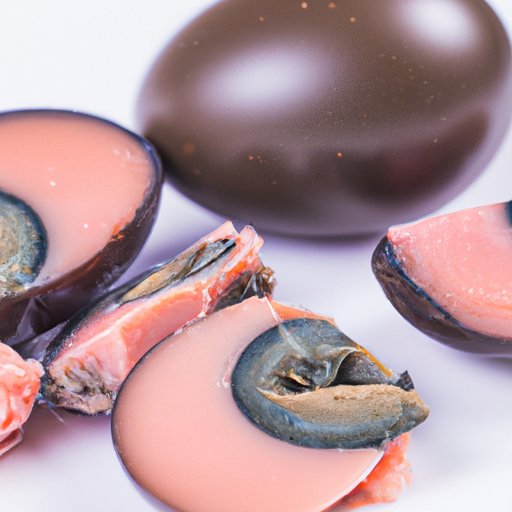
Introduction
Century egg, also known as preserved egg or thousand-year egg, is a delicacy that has been enjoyed for centuries across different parts of Asia. Known for its unique flavor profile and texture, this food item has gained popularity worldwide for its cultural significance, science behind its making process, and its supposed health benefits. If you are curious about how to make century egg at home and creative ways to cook it, this article is for you.
A Step-by-Step Guide on How to Make Century Egg at Home
The century egg originated from China, where it was created accidentally by a farmer who stumbled upon some duck eggs that had been left in a mixture of clay, ash, salt, and quicklime for several months. Since then, it has become a popular food item in many Asian countries, particularly China, where it is eaten as a snack or used as an ingredient in different dishes.
To create your own century egg at home, you will need the following ingredients:
- Fresh duck, chicken, or quail eggs
- Sodium carbonate
- Calcium hydroxide
- Sea salt
- Water
Here are the step-by-step procedures on how to make century egg at home:
- Dissolve the sodium carbonate in water to create an alkaline solution.
- Mix the calcium hydroxide with water until it becomes a paste.
- Combine the alkaline solution and calcium hydroxide paste to make the preserving mixture.
- Coat the eggs with the preserving mixture.
- Wrap the eggs individually in plastic wrap or newspaper.
- Place the wrapped eggs in a container and store them in a cool, dark place for anywhere between 21 and 90 days. This allows the eggs to ferment and become preserved.
- After the desired amount of time, remove the eggs from the preserving mixture and rinse them under cold water.
- The century eggs are now ready to be eaten or used in any recipe of your choice.
As with any recipe, there are a few tips for success. Use fresh and clean eggs to ensure that the final product is of good quality. You can also experiment with different preserving mixtures to achieve different flavors and textures.
Creative Ways to Incorporate Century Eggs in Your Cooking
Century eggs have a unique flavor profile and texture that can be enjoyed in many different ways. They have a creaminess similar to hard-boiled eggs but with a richer, more pungent taste. Here are some ideas for incorporating century eggs into your cooking:
- Century egg congee: Boil rice in chicken broth or water until it’s thick and creamy, then add sliced century eggs, ginger, soy sauce, and green onions for a savory and comforting breakfast or meal.
- Century egg salad: Combine sliced century eggs with shredded lettuce, cucumber, and carrots. Dress with vinegar, sesame oil, and soy sauce for a refreshing and zesty salad.
- Century egg fried rice: Fry rice with scrambled eggs, veggies, and diced century eggs for a quick and satisfying meal.
Century eggs also pair well with tofu, pork, and seafood. Consider using them as a topping for ramen, as a filling for dumplings, or in a hot pot. The options are endless.
The Science Behind How Century Eggs Are Made
The process of making century egg involves a chemical reaction that alters the structure and composition of the egg, resulting in its unique flavor and texture. Here is a breakdown of the science behind the making of century eggs:
Salt, clay, and an alkaline solution are the three main components that are used to create the preserving mixture. The mixture is applied to the egg, causing it to react with the solution. The high pH levels in the mixture break down the proteins in the egg, releasing amino acids and peptides that give it its savory flavor. The alkaline solution also causes the egg yolk to turn greenish-grey, while the egg white turns brown and translucent, resulting in a distinct appearance.
Nutrient-wise, century eggs contain a high amount of protein and various vitamins and minerals, including vitamin D, calcium, and iron.
Exploring the Cultural Significance of Century Eggs Around the World
Century eggs are enjoyed in different ways across various cultures. They are particularly popular in Asia, where they feature prominently in traditional cuisine and cultural rituals.
In China, century eggs are traditionally eaten during the spring equinox festival and have symbolic importance for fertility and rebirth. In Vietnam, century eggs are often served with congee or used as a topping for banh mi sandwiches. In Thailand, they are sometimes served in a salad with chili paste and fish sauce.
The Health Benefits of Century Eggs: Fact or Fiction?
There are many myths surrounding the supposed health benefits of century egg, such as that it can improve bone health or boost the immune system. While some of these claims are exaggerated or unsupported by scientific evidence, there are still some nutritional benefits to consuming century eggs in moderation.
Century eggs are an excellent source of protein and contain several vitamins and minerals that are essential for maintaining good health. They are also low in calories, making them a healthy addition to any diet.
However, it is important to consume century eggs in moderation, as they are high in sodium and may contain traces of harmful bacteria if not prepared properly.
Conclusion
In conclusion, century eggs are a unique and delicious food item that has been enjoyed for centuries across the world. Knowing how to make century egg at home and creative ways to cook it allows you to explore this delicacy. The science behind how century eggs are made, cultural significance, and nutritional benefits make them a fascinating and healthy choice. Remember to enjoy them in moderation and try incorporating them into your cooking for a new and exciting culinary experience.





